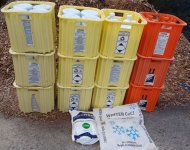This is a new one for me, now when I finally get my numbers where I thought they needed to be to be balanced and now check to see how the overall water condition is, it's way off.
I played around with the calculator it to find it's because of the water temperature. I had input 80 degrees a couple of months ago and I re-checked it is now 55 degrees. To get the numbers I need to get to between -6 to 6 means I need to raise my PH from 7.4 to 7.8 (which I understand will lower the effectiveness of my chlorine) and the TA from 80 to 120 now to get CSI/LSI from -59 to -2. This just gets more mind boggling! Why does the temperature cause my pool to appear in trouble now? And what will it mean to now increase my PH/TA for the winter months? I never realized I would have to make changes in water balancing just chlorine level and maybe less pump run time.
CH 300
CYA 30
Borates 30
Salt 2750
I played around with the calculator it to find it's because of the water temperature. I had input 80 degrees a couple of months ago and I re-checked it is now 55 degrees. To get the numbers I need to get to between -6 to 6 means I need to raise my PH from 7.4 to 7.8 (which I understand will lower the effectiveness of my chlorine) and the TA from 80 to 120 now to get CSI/LSI from -59 to -2. This just gets more mind boggling! Why does the temperature cause my pool to appear in trouble now? And what will it mean to now increase my PH/TA for the winter months? I never realized I would have to make changes in water balancing just chlorine level and maybe less pump run time.
CH 300
CYA 30
Borates 30
Salt 2750


